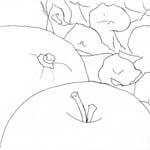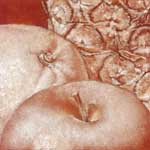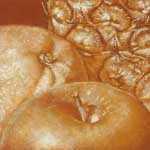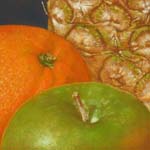
|
A sketch of the painting is transferred to a white gesso prepared panel or canvas.
|

|
A background, or "imprimatura" of evenly and transparently applied oil paint (in this example, earth red) is the base into which white egg tempera emulsion is painted, establishing the shading and modeling of the subject. This step must be completed while the oil layer is still tacky. The oil base is very lean, with only a small amount of painting medium added.
|

|
A second thin glaze of oil paint (yellow ochre here) is applied after the first underpaint is completely dried (usually 4-7 days). White tempera is again applied into the wet oil, developing only the brightest highlights on this layer. This stage is again allowed to dry completely as one wishes to avoid dissolving or disturbing lower layers with subsequent ones.
|

|
Local color is next applied to individual objects as a lean oil glaze, applied thinly, as opposed to being thinned out with painting medium. Often, areas are patted down with the finger to ensure transparency. Adjacent areas should be painted separately after the first has dried to the touch so as not to mix colors across lines. Multiple hues or tints should not be applied at the same time to one object, but a color to be blended should be applied over the first after it has dried. White tempera can be added lightly over wet oil areas to maintain highlights.
|

|
Shading, modeling and shadowing of darker areas takes place after the local colors have dried. A neutral tinted glaze is applied to provide shade and shadow, which can be a mixture of an earth red and ultramarine blue, proportioned warmer or cooler as needed.
|
|
|
The painting is varnished after completely dry (at least six months) with Damar varnish.
|





